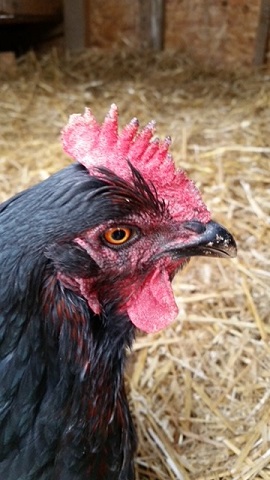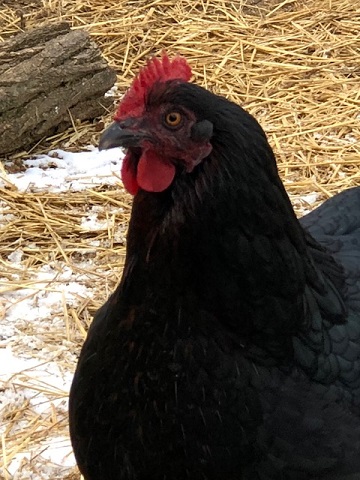
Brrr! It’s cold outside. Not just cold, but freezing cold temperatures and brutal wind chills!
I like to think that I am deliberate in tending to our flock of chickens this time of year, but it still happened! Yep, one of our chickens got frostbite on her comb.
See those black spots on the comb? That’s frostbite. Thankfully it didn’t get any worse and it naturally took care of itself. But, because this was my first experience with frostbite, I did lots of research and thought I would share my finds with you for treating and preventing frostbite on chickens.
I’ve come to realize that most cold climate chicken keepers will deal with frostbite one time or another. When researching this topic, a friend told me that one of her chickens lost a toe last year, most likely to frostbite.
Factors other than frigidly cold temperatures can contribute to frostbite. Did you know that wind chill and moisture/dampness can also cause frostbite? Also, water dripping onto the wattles puts a chicken at high risk for frostbite, especially in extremely cold temps. Combs, wattles, and feet are susceptible to frostbite in chickens.
Frostbite on chickens appears as black spots. These spots are dead tissue that will fall off and will not grow back. But don’t worry, the area will heal. DO NOT try to break off the black spots, rub them, or try to trim them away! Doing so can cause infection or further damage.
Minor cases of frostbite usually aren’t anything to worry about, but more serious cases can cause pain and/or infection. Watch for other chickens who may try pecking at the frostbitten area. For these reasons, isolation may be needed. Last year, I had another friend that had a frostbitten chicken. She moved that chicken inside the house for most of the winter, tending to it ever so gently.

Preventing Frostbite
As with most things, prevention is important. Though not a definite, some things can be done ahead of a cold snap hitting your flock to help ward off frostbite.
Keep the inside of the coop dry and weatherproof
Keep the bedding thick and dry. I like to use straw in our coop. Straw has ‘pockets’ that act as insulation. If using the deep litter method, be sure to stir the bedding frequently, and add more straw as needed.
Do not keep the chicken’s drinking water inside the coop.
Ventilation
Even in the winter, a coop should be well ventilated. Ventilation helps prevent moisture inside the coop, which is naturally caused by droppings (poo).
Roosting bars
Chickens naturally roost and in the winter this can actually help prevent frostbite. When cold, a chicken will puff out, helping to maintain a good body temperature. Sometimes they puff out enough to cover (and protect) their feet. Chickens also roost side by side, helping to keep each other warm.
Petroleum Jelly
Applying petroleum jelly to a chicken’s comb and wattle can be used as a preventative measure, but will not help once frostbite has settled in. Do not apply it to an already affected area, as it may cause damage.
Treating frostbite
Again, mild cases will naturally heal themselves. Although it can be stressful to watch, it is normal for the affected area to turn black, harden, and eventually fall off. Just let nature take its course.
Do keep an eye on the chicken and the affected area though. Make sure the chicken doesn’t seem to be in pain. Watch for signs of infection, which may include swelling, blisters, or discharge. If these happen, you may need to interfere.
Electrolytes
Electrolytes can be given sparingly. Doing so may give the chicken a little boost in her immune system.
Take the chicken inside
Severe frostbite can be treated by warming the chicken slowly. Take the chicken inside where it is warm. If the feet are affected, you can soak them in warm water. But…If you choose to bring the chicken inside your home, it should be kept inside until the frostbite is gone, preventing further damage. Like my friend Susan did, make a comfy area for both the chicken and you. Recovery can take 4 to 6 weeks.
The last thing I want to discuss is a highly debatable topic — heating the coop. Aside from the risk of fire, I think it is important to understand another risk… Heating the coop can actually cause moisture inside the coop, which in turn can cause frostbite. Something else to think about: going from a warm, heated coop to a freezing cold outside temp is not good for a chicken’s overall health.

So, what happened to our chicken? As you can see in this picture, she has only a few black spots left and doesn’t seem to be affected by the frostbite otherwise.













1 Comment
Thanks for sharing. I absolutely loved your ideas.